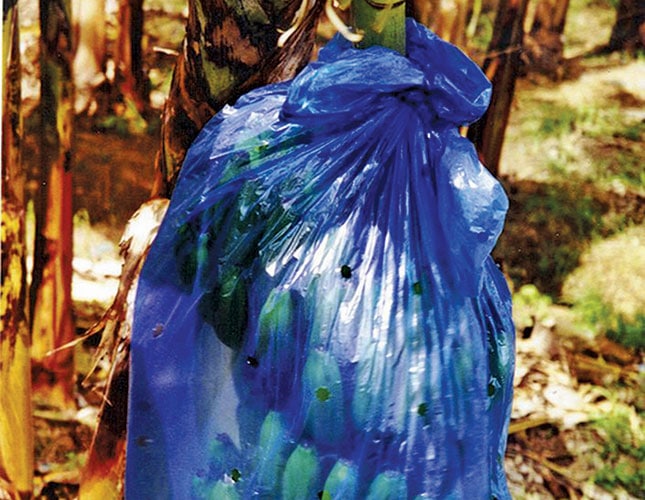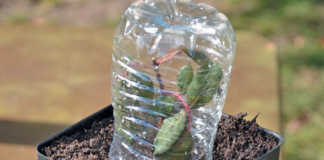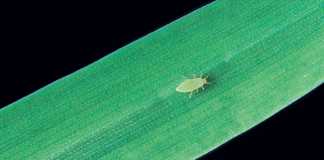
Banana fruits develop in a large hanging cluster, made up of tiers (called ‘hands’), with up to 20 fruit to a tier. The hanging cluster is known as a bunch, and can comprise three to 20 tiers.
Once your banana plants are growing, cover the bunches with bags for protection against insects and wind.
At the same time, remove lower-hanging yellow leaves. This will result in better quality bananas. Remove the lower leaves from the plant as they get old because they can spread diseases and scratch the bunches.
Use a knife to cut off the leaves – do not pull them. Place the leaves on the ground as mulch to increase the nutrient content of the soil. Banana plants usually need support when heavy with fruit; provide this by propping the bunches with a rope and sticks.
Controlling weeds
Use only recommended chemicals applied strictly according to the instructions on the label. Do not spray the banana plants or spray when it’s windy.
When using chemical control, such as glyphosate or paraquat, protect all parts of the banana plant from spray drift.
Use a hoe or your hands to kill weeds in the area near the plant to avoid chemical spray contact with the plants.
Pest and disease control
- Thrips: Use chlorpyrifos pesticide once a month to kill thrips if they are present.
- Nematodes: If these are present, kill them with Nemacur using 45kg/ ha (20g/plant). Compost, kraal manure and chicken manure applied in ample quantities will also suppress nematodes. Tissue culture plants are free of nematodes, which is one of the reasons that this is the preferred method of cultivation.
- Black sigatoka: Plants with leaves damaged by the disease may have up to 50% lower fruit yield. Spray with Dithane and mineral oil. The latter enhances the penetration of the fungicide in the leaves and reduces leaching from rain. Ask your extension officer or chemical rep for advice. Finally, dip the banana hands into Benlate solution (5g/10l water) to prevent post-harvest decay.
Harvesting
Harvest bananas when they are swollen and green, but before they become ripe (plump and yellow). Do not harvest when the bananas are thin and dark green.
Harvest early in the morning when the sun is not too hot. Do not leave cut bunches lying in the sun. Get at least two people to help you to cut the banana pseudo-stem halfway across and halfway down.
Let the plant drop slowly and then remove the bunch by cutting the bunch stalk. Do not let the bunches fall to the ground.
Chop up the leaves and top part of the pseudo-stem and lay it on the soil as a mulch. Carry the bunches to the trailer and lay them next to each other; never place them on top of each other.
In the packhouse, which should be built in a cool location, hang bunches, remove hands, cut into clusters, pack into cartons and store, preferably on the southern side of the building.
Source: ‘Banana Production’, compiled by Directorate Communication, department of agriculture in conjunction with the ARC-Institute for Tropical and Subtropical Crops.













